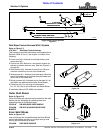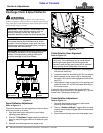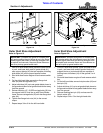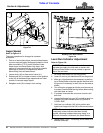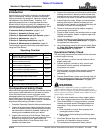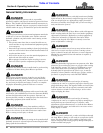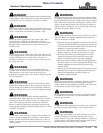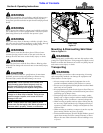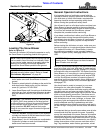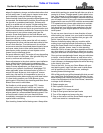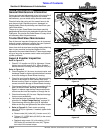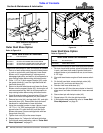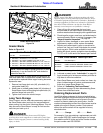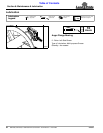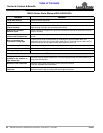
27
Section 5: Operating Instructions
3/18/15
SBL2566, SBL2574, & SBL2584 with S/N 891531+ Snow Blowers 370-478M
Table of Contents
Reading Level Run Indicator
Figure 5-2
Leveling The Snow Blower
Refer to Figure 5-2:
The level run indicator (#2) helps the operator to verify
the Snow Blower is operating parallel to the ground.
1. Stop skid steer/tractor on a flat level surface and
lower loader arms until Snow Blower is close to
ground.
2. Extend or retract hydraulic cylinders on the end of the
skid steer/tractor loader arms until the indicator
arrow (#1) points to “LEVEL RUN”.
3. Lower Snow Blower until it is resting on its skid shoes
and make any final adjustments necessary to make
sure the indicator arrow (#1) still points to “LEVEL
RUN”.
4. Once set, DO NOT change position of the hydraulic
cylinders on the end of the skid steer/tractor loader
arms. See important note above.
5. Repeat steps 1 thru 4 if skid shoes are readjusted or
if hydraulic cylinders on end of skid steer/tractor
loader arms have been moved.
37227
NOTE: Most tractor loaders have a leveling rod that
can be used in lieu of the level run indicator. Refer
to your tractor loader manual to properly adjust the
leveling rod. Leveling rod must be adjusted to
operate the Snow Blower parallel to the ground.
IMPORTANT: The level run indicator must be
adjusted correctly before using it. Refer to “Level
Run Indicator Adjustment” on page 22.
IMPORTANT: The indicator arrow (#1) should point
to “LEVEL RUN” when parked on flat level ground
and Snow Blower is sitting on the ground. It is normal
for the indicator arrow to move from “LEVEL RUN”
during operation. DO NOT readjust hitch angle.
Doing so can cause the auger to contact the ground
and damage it.
General Operator Instructions
It is important that you familiarize yourself with the
Operator’s Manual, properly attach the Snow Blower to
your skid steer or tractor front loader, completed the
operating checklist and pre-operating safety check
before running the operational safety check.
You will want to park on a flat level surface and level your
Snow Blower to operate parallel to the ground before
making any operational safety checks or removing snow.
If you have not leveled the Snow Blower, please
complete this procedure before continuing.
If you detect a malfunction in either your Snow Blower or
skid steer/tractor during the operational safety check,
immediately shut skid steer or tractor off, remove switch
key, and make all necessary repairs and adjustments
before continuing.
Before starting the skid steer or tractor, make sure your
machine is in park or in neutral and the park brake is set.
Turn hydraulic function off. If Snow Blower is tractor
mounted and powered by a rear mounted Hydraulic
Reservoir System (HRS), disengage tractor PTO to the
HRS.
With your Snow Blower resting on the ground and loader
arms set to float, start your skid steer or tractor and set
engine throttle speed at a low idle. Engage PTO if tractor
mounted with a rear mounted HRS. Turn hydraulics to the
Snow Blower on. If everything is running smoothly at a
low idle, slowly increase skid steer/tractor engine RPM
until the Snow Blower reaches full operating speed. If
everything is still running smoothly, return engine to low
idle, turn hydraulic function to off, and when applicable,
disengage PTO.
You should now be ready to transport to your snow
blowing site at a safe ground speed. On roadways
transport in such a manner that faster moving vehicles
can easily see you and pass you safely. Reduce your
speed when travelling over rough and hilly terrain. Avoid
quick or sharp steering corrections. Take extra care to
ensure that the Snow Blower doesn’t come into contact
with obstacles such as trees, buildings, or fences. Use
accessory lights and appropriate reflective devices to
provide adequate warning to pedestrians and other
vehicle operators when traveling on public roads and in
the dark of night. Comply with all local, state, and federal
laws.
It is important that you know the area where snow is to be
removed and what lies beneath the snow. If possible,
survey the area ahead of the snow. Remove all possible
obstructions and mark any obstructions that cannot be
removed with flags that project above the snow. If you are
unfamiliar with the area, ask someone who can identify
hidden obstructions so that you can mark them with a
flag. Flag manholes, water meters, gas meters, culvert
IMPORTANT: Set loader arms to float before
blowing snow. The skid shoes can have increased
wear if loader arms are rigid.



